Espresso
Mastering Long Espresso Extraction Times
Harness the potential of long espresso extraction times to unlock a world of rich flavors and balanced profiles – discover the secrets within!
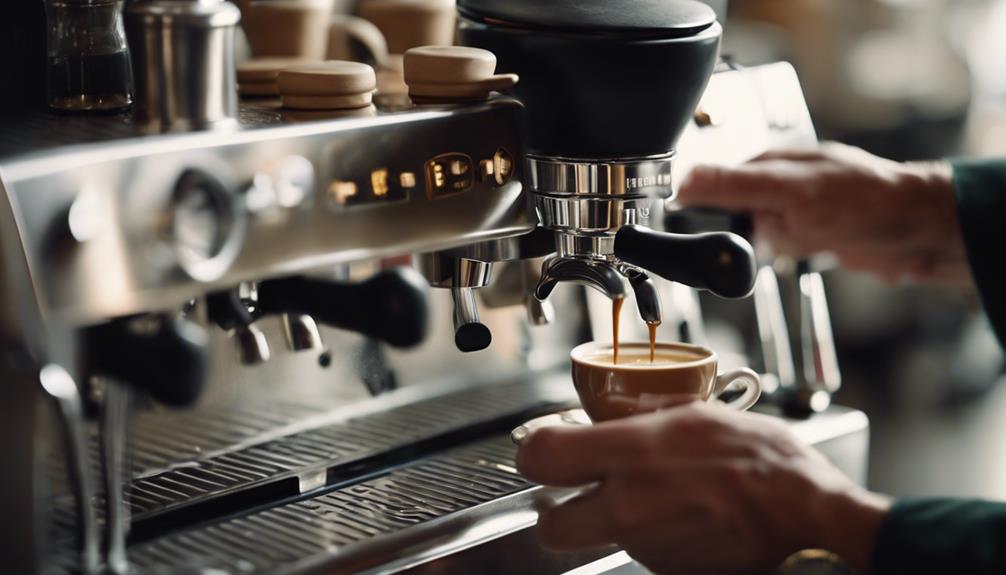
To master long espresso extraction times, aim for a balanced flavor profile by adjusting grind size, water temperature, and extraction time. Longer extraction enhances sweetness and body, while shorter times balance acidity. Factors like grind size and water temperature influence taste. Avoid bitterness by monitoring extraction time and adjusting grind size. Fine-tune dose and tamping pressure for best results. Experiment with different grind sizes for a nuanced flavor experience. Achieve a harmonious brew by finding the sweet spot in extraction. Balancing these elements elevates your coffee enjoyment to new heights.
Key Takeaways
- Experiment with grind size adjustments for optimal extraction control.
- Avoid exceeding 40 seconds for extraction time.
- Use coarser grind for smoother flavor in long espresso.
- Focus on grind size adjustments for flavor perfection.
- Aim for a balanced flavor profile in long espresso shots.
Understanding Long Espresso Extraction
To grasp the concept of long espresso extraction, consider it as a method that prolongs the brewing process to achieve a milder and more balanced flavor profile. When brewing lungo shots, the water-to-coffee ratio is typically higher than in traditional espresso, leading to an extended extraction process. This longer extraction time results in a smoother taste profile with reduced intensity compared to standard espresso.
The light body and decreased crema of lungo shots are a direct outcome of this method. By balancing the intensity of espresso with the smoothness of drip coffee, lungo shots offer a unique experience for coffee enthusiasts. Mastering espresso extraction involves understanding this balance between intensity and smoothness, ensuring that the flavors are harmoniously combined.
Experimenting with different extraction times and ratios can help you tailor your brew to suit your preferences, allowing you to enjoy a well-crafted cup of long espresso tailored to your taste.
Importance of Extraction Time Measurement

Monitoring extraction time during the preparation of long espresso shots is essential for achieving consistent flavor and quality in your coffee. Extraction time measurement typically falls between 35-45 seconds for a balanced taste profile.
Longer extraction times for lungo shots enable a more extended interaction between water and coffee grounds, extracting various flavor compounds. It's important to monitor extraction time to prevent over-extraction, which can lead to a bitter and astringent taste in your espresso.
Consistent extraction time measurement guarantees repeatability in flavor and quality for your long espresso shots. The extended extraction times associated with long espresso shots help extract more coffee solubles, resulting in a fuller-bodied and more nuanced flavor profile.
Factors Influencing Extraction Time

Grind size greatly influences how long it takes to extract an espresso. The finer the grind, the shorter the extraction time typically becomes.
Water temperature and pressure also play vital roles in determining the length of the extraction process.
Grind Size Impact
Selecting the appropriate grind size greatly influences the extraction time for long espresso shots. The table below illustrates how grind size impacts extraction times, flavor profile, and consistency in long espresso shots.
| Factors to Consider | Impact on Extraction Time & Flavor Profile |
|---|---|
| Grind Size | Finer grind sizes lead to shorter extraction times, resulting in a more intense flavor profile. Coarser grind sizes extend extraction times, offering a more balanced and nuanced taste. Consistency in grind size is essential for maintaining flavor intensity. Adjusting grind size allows control over extraction, ensuring a well-balanced shot. |
Water Temperature Effects
To optimize extraction time and flavor balance in long espresso shots, closely monitoring water temperature is essential. The temperature of the water used during espresso extraction has a substantial impact on the extraction process by influencing how quickly coffee solubles are dissolved.
The ideal water temperature for espresso extraction typically falls between 195-205°F. Higher water temperatures can expedite the extraction process, potentially resulting in a faster extraction time. However, this can lead to imbalances in flavor if not carefully controlled.
On the other hand, lower water temperatures may prolong the extraction time, running the risk of over-extraction and a bitter taste in the final espresso. Therefore, maintaining precise water temperature control is vital to achieving consistent and balanced espresso extraction.
Coffee Freshness Importance
Monitoring water temperature is vital for optimizing extraction time in long espresso shots; now, let's shift our focus to the importance of coffee freshness on extraction time. Fresh coffee beans play a pivotal role in achieving the best extraction time, as stale beans can lead to uneven extraction and off-flavors in your espresso.
The freshness of the beans greatly influences the release of desirable compounds during extraction, ultimately impacting the overall taste profile of your coffee. The degassing process in freshly roasted beans is also a key factor affecting extraction time. It determines how gases interact with water during the extraction process, influencing the flavor extraction.
To maintain coffee freshness, store your beans in airtight containers away from light and heat. This ensures consistent extraction times and preserves the quality of your espresso. Additionally, freshly ground coffee contributes to a more uniform particle size distribution, promoting even extraction and enhancing the overall extraction time of your espresso.
Controlling Grind Size for Extraction
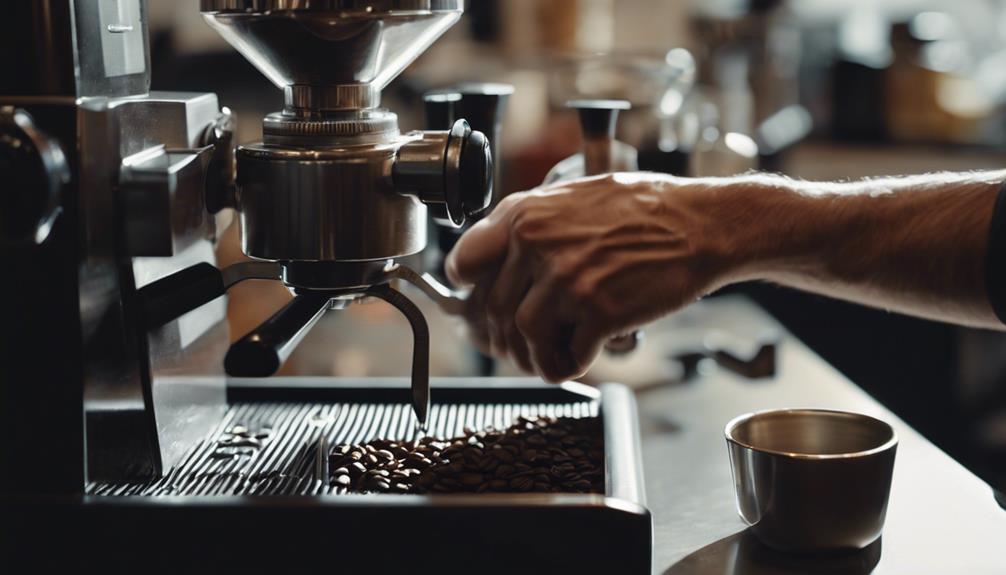
Adjust your grind size to influence the extraction speed and achieve the desired extraction time for your long espresso drinks. Grind size greatly impacts the flow rate of water through the coffee grounds, affecting the extraction process.
When aiming for a longer extraction time in your lungo or long espresso shots, opt for a coarser grind size, as this will slow down the extraction process. Conversely, if you prefer a shorter extraction time for regular espresso shots, a finer grind size is more suitable.
Experiment with different grind sizes to find the one that aligns with your desired extraction time for long espresso beverages.
Consistent grind size is essential for maintaining the flavor profiles and balance in your long espresso shots.
Customizing your grind size allows for ideal taste and a personalized extraction experience, enhancing the overall quality of your long espresso drinks.
Water Temperature's Role in Extraction
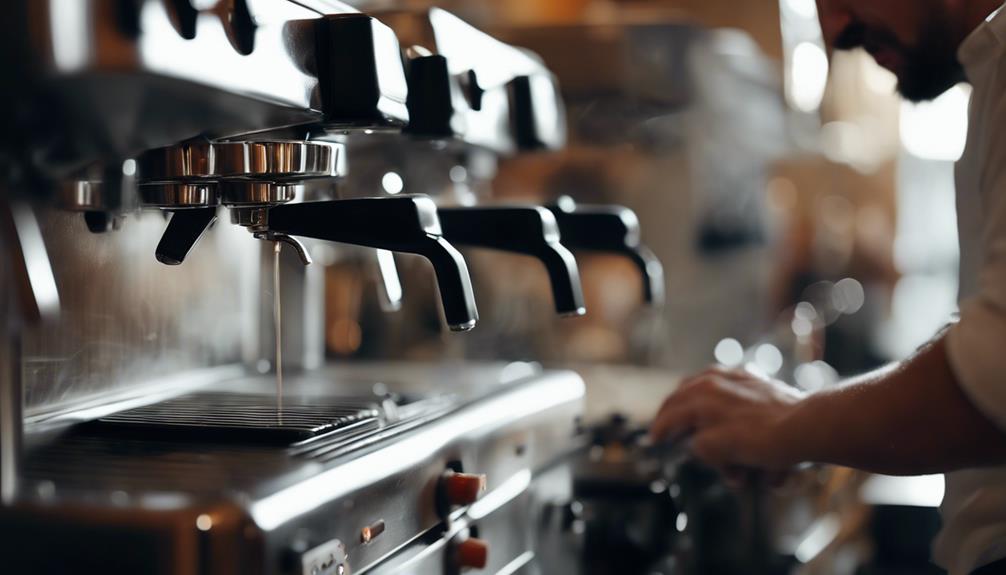
The water temperature you use when brewing espresso has a significant impact on the flavor of your shot.
At temperatures between 195-205°F, you can extract the best balance of flavors and compounds from the coffee grounds.
Optimal Water Temperature
Maintaining the ideal water temperature range of 195-205°F is essential for peak flavor extraction during long espresso preparation.
When aiming for the perfect long espresso extraction, consider the following:
- High water temperature helps break down coffee compounds, leading to a well-balanced taste profile.
- Ensuring the correct water temperature is essential for proper extraction of coffee solubles without risking scorching the grounds.
- Consistent water temperature throughout the extraction process is important to avoid under or over-extraction flavors in your long espresso shots.
Impact on Flavor
To enhance the flavor extraction process in long espresso shots, ensuring the water temperature falls within the ideal range of 195-205°F is vital. Water temperature plays a pivotal role in the extraction process, influencing the overall taste of your espresso.
If the water temperature is too high, it can lead to over-extracted, bitter shots due to the accelerated extraction process. Conversely, if the water temperature is too low, it may result in under-extracted, sour shots as the extraction time is prolonged.
Finding the right balance between water temperature, grind size, and dose is key to achieving a well-rounded flavor profile in your long espresso shots. By maintaining the water temperature within the recommended range and adjusting other variables accordingly, you can optimize the extraction process to produce a rich and balanced flavor that truly highlights the nuances of your coffee beans.
Adjusting Extraction Time Manually

For ideal results in your espresso brewing, consider manually adjusting the extraction time to fine-tune the flavor profile.
Here are some tips for adjusting extraction time manually:
- Lengthen the extraction time to enhance sweetness and body in your espresso.
- Experiment with shorter extraction times to balance acidity and reduce bitterness in your shot.
- Play around with different extraction times to uncover unique flavor notes that may be hidden in your coffee beans.
Impact of Extraction Time on Flavor
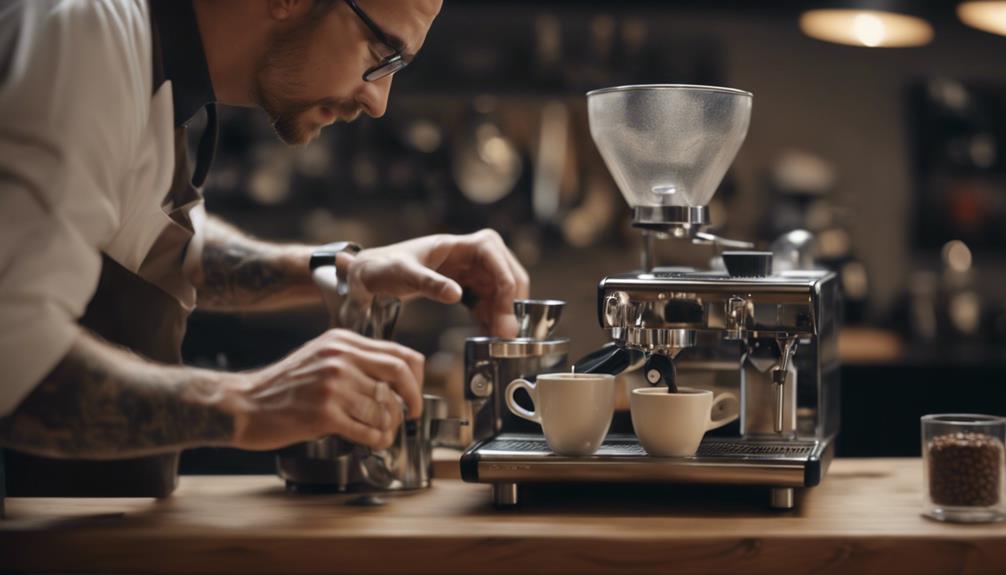
Lengthening the extraction time significantly impacts the flavor profile of your lungo shot, enhancing certain characteristics while potentially introducing new ones.
When opting for extended extraction times around 40-45 seconds, expect a milder flavor profile with a noticeable increase in acidity. This prolonged extraction allows for a greater variety of compounds to be extracted from the coffee grounds, resulting in a smoother taste.
The longer contact time between water and coffee grounds during extraction plays an important role in influencing the balance of flavors in your lungo shot. However, be mindful that this prolonged extraction may also bring forth a more pronounced bitterness compared to traditional espresso.
Despite the extended extraction time, it's essential to uphold the ideal grind size, dose, and water temperature to achieve a well-balanced lungo shot that highlights the complexities of the coffee beans.
Preventing Over/Under Extraction

Preventing over or under extraction in your espresso is crucial for achieving a balanced and flavorful shot. To guarantee you hit that perfect balance, consider the following:
- Monitor Extraction Time: Keep a close eye on the extraction time to avoid over-extraction, which can lead to bitterness, or under-extraction, causing a sour taste. Aim for the ideal range of 25 to 35 seconds for a well-rounded shot.
- Adjust Grind Size: Fine-tune your grind size to control the flow rate of water through the espresso puck. A finer grind can slow down extraction, preventing over-extraction, while a coarser grind can speed it up, preventing under-extraction.
- Taste and Adjust: Regularly taste your espresso shots and make adjustments as needed. This hands-on approach allows you to dial in the flavor balance and make sure each shot is just right.
Achieving Balance in Long Espresso

Achieving balance in long espresso extraction involves fine-tuning grind size, dose, and tamping pressure for peak flavor extraction.
When aiming for longer extraction times ranging between 30-40 seconds, it's important to find the sweet spot where the flavors harmonize without becoming overpowering.
Adjusting the grind size can impact the rate of extraction, influencing the balance of the final brew. Similarly, the dose of coffee grounds and the tamping pressure applied play significant roles in achieving the desired flavor profile.
The extended extraction time allows for the extraction of more flavor compounds, resulting in a nuanced taste experience with enhanced complexity.
Consistency is key in long espresso extraction to avoid over-extraction, which can lead to bitterness overpowering the subtle notes in the coffee.
Tips for Mastering Extraction Time
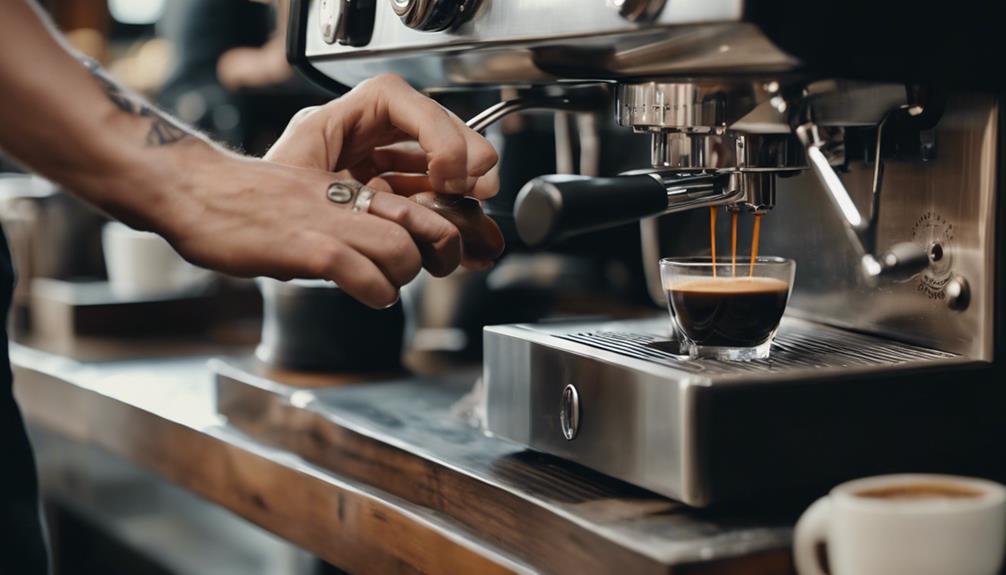
To master extraction time when brewing long espresso shots, focus on adjusting the grind size for the best flavor extraction. Here are some essential tips for achieving the perfect balance of flavors:
- Experimentation is Key: Try different grind sizes to see how they affect the extraction time and flavor profile of your long espresso shots.
- Avoid Over-Extraction: Be cautious of extending the extraction time beyond 40 seconds, as this can lead to a more diluted flavor profile.
- Seek a Smoother Flavor: Lengthen extraction times by using a coarser grind size for a milder taste and smoother flavor in your long espresso shots.
Frequently Asked Questions
What Is the Long Extraction Time for Espresso?
A long extraction time for espresso typically ranges between 30-40 seconds, resulting in a lungo shot. This type of shot is brewed with more water than regular espresso, giving it a milder taste and lighter body.
The extended extraction time of a lungo results in less crema but a stronger aroma and higher acidity. It offers a unique balance between the intensity of espresso and the smoothness of a longer brew.
How Do You Extract Espresso Longer?
To extract espresso longer, adjust your grind size and dose carefully. This tweak helps maintain a prolonged extraction without messing with the taste.
By fine-tuning these factors, you can achieve a drawn-out extraction time, giving your brew a more intense flavor. But keep an eye on the process to dodge any bitterness creeping in.
Consistent monitoring is key to nailing that longer extraction for a complex and balanced taste profile.
What Happens if You Extract Espresso Too Long?
When you extract espresso for too long, over 40 seconds, the taste can become bitter, astringent, and burnt. This happens because undesirable compounds are extracted from the coffee grounds during prolonged extraction.
The bitterness intensifies as more bitter compounds are extracted, leading to an unbalanced, harsh flavor profile. The espresso loses its natural sweetness, acidity, and aroma, resulting in a less enjoyable drinking experience.
Monitoring extraction time is essential to avoid these negative outcomes.
Is 40 Seconds Too Long for Espresso?
Extraction time of 40 seconds in espresso is indeed considered too long. This extended duration can lead to over-extraction, resulting in a bitter and unappealing taste. It's essential to aim for a balanced shot within the 25 to 35-second range to achieve the best flavor.
Over-extracted espresso lacks the desired sweetness, acidity, and complexity, impacting the overall taste experience. Adjusting factors like grind size and dose can help you avoid the pitfalls of over-extraction.
How can I prevent my espresso from being under extracted during long extraction times?
There are several factors that can lead to under extracted espresso causes during long extraction times. Adjust the grind size to be finer, use a higher brewing temperature, or increase the amount of coffee grounds to prevent this issue. Experiment with these variables to achieve a well-extracted espresso.
Does Grinding Coffee Beans for Long Espresso Extraction Times Affect the Flavor?
When it comes to grinding coffee beans for espresso, the extraction time can greatly affect the flavor. Longer extraction times can lead to over-extraction, resulting in a bitter and unpleasant taste. It’s important to find the right grind size and extraction time to achieve the perfect balance of flavors in your espresso.
Conclusion
Mastering long espresso extraction times is like finding the perfect balance in a dance routine – it requires precision, timing, and finesse.
By understanding the factors that influence extraction time, controlling grind size and water temperature, and preventing over/under extraction, you can achieve a harmonious and flavorful cup of espresso.
With practice and patience, you can become a skilled espresso extraction maestro, creating a symphony of flavors with each carefully crafted shot.
Espresso
The Ultimate Guide to Espresso Powder – Enhance Your Baking!
Find out how to unlock the secret to rich, decadent baked goods with the ultimate guide to espresso powder and take your baking to the next level.

You're about to reveal the secret to taking your baking to the next level with espresso powder! Made from darkly roasted coffee beans, this concentrated flavor booster is perfect for enhancing chocolate recipes. Use ¼ to 1 ½ teaspoons to add depth without overpowering your treats. Store-bought or homemade, espresso powder dissolves easily in hot water and lasts up to five months in an airtight container. With its ability to elevate flavor without bitterness, you'll wonder how you ever baked without it. Now, discover how to harness its full potential and transform your baked goods into rich, decadent masterpieces.
Key Takeaways
- Espresso powder is a concentrated flavor booster made from darkly roasted coffee beans, ideal for enhancing chocolate recipes.
- Homemade espresso powder can be made by baking and grinding roasted espresso beans, yielding approximately one cup of powder.
- Espresso powder elevates the flavor of baked goods, particularly chocolate desserts, without adding a strong coffee taste.
- When using espresso powder, dissolve it in hot water before adding to recipes for better flavor distribution and account for additional liquid.
Understanding Espresso Powder
To start working with espresso powder, it's essential that you understand what it's made of and how it can enhance your baked goods, especially those that feature chocolate.
Espresso powder is made from darkly roasted coffee beans that are brewed, dried, and ground into a fine powder. This process creates a concentrated flavor booster that's perfect for baking. When used in moderation, espresso powder can intensify the cocoa flavor in chocolate recipes, such as cakes and brownies, without imparting a strong coffee taste.
When working with espresso powder, it's vital to measure it carefully. The recommended amount ranges from ½ to 1 ½ teaspoons, depending on the recipe. Unlike instant coffee, espresso powder is more concentrated and dissolves easily in hot water, making it ideal for incorporation into batters and frostings.
To maintain its flavor potency, store your espresso powder in an airtight container. With proper storage, homemade espresso powder can last up to five months.
Making Your Own Espresso Powder
Now that you're familiar with the benefits and uses of espresso powder, let's explore how you can make your own at home.
To start, preheat your oven to 200°F and spread roasted espresso beans in a single layer on a baking sheet. Bake them for about an hour, or until they're lightly toasted and dried. Once cooled, grind the beans in a coffee grinder or food processor until they reach a fine powder consistency. This guarantees uniformity and ideal flavor.
You'll be pleased to know that one cup of roasted espresso beans yields approximately one cup of espresso powder, making it a cost-effective option compared to store-bought alternatives.
For the best flavor profile, use organic, medium roast espresso beans. Once you've ground your beans, store the freshly ground espresso powder in an airtight container. This will maintain its freshness and potency for up to 5 months.
With your homemade espresso powder, you can enhance your baked goods with a rich, intense flavor. Simply use it in place of store-bought espresso powder to elevate your recipes. By making your own espresso powder, you'll have complete control over the flavor and quality of your ingredients.
Using Espresso Powder in Baking

When incorporating espresso powder into your baked goods, you'll find that it can markedly enhance the chocolate flavor in treats like cakes, brownies, and cookies without imparting a strong coffee taste, as long as you use it in moderation. To get the most out of your espresso powder, dissolve it in hot water before adding it to your recipe. This guarantees ideal flavor distribution and prevents any bitter notes from forming.
| Espresso Powder Tips | Benefits |
|---|---|
| Use ¼ to 1 ½ teaspoons per recipe | Enhance chocolate flavor without strong coffee taste |
| Dissolve in hot water before adding | Prevents bitter notes and guarantees ideal flavor distribution |
| Account for additional liquid in recipes | Dissolved powder contributes moisture, affecting final texture |
When using espresso powder, you can achieve a depth of flavor similar to brewed espresso without the hassle of brewing. One teaspoon of espresso powder is equivalent to one shot of espresso, making it a convenient addition to your baking routine. Pair it with Dutch process cocoa for an intense chocolate flavor that will elevate your baked goods to the next level.
Benefits and Substitutes Explained
As you explore the benefits of using espresso powder in your baking, it's helpful to understand its role in enhancing flavor and the options available when it's not on hand. Espresso powder is a game-changer for chocolate desserts, intensifying the flavor without leaving a strong coffee taste.
If you're out of espresso powder, don't worry! You can substitute it with dry instant coffee, but keep in mind that you'll need to use 50% more than the recipe calls for.
Here are some key points to reflect on when working with espresso powder:
- Flavor enhancement: Espresso powder elevates the flavor of baked goods, especially chocolate desserts.
- Substitutes: Instant coffee can be used as a substitute, but it may lead to a slightly bitter flavor.
- Homemade option: Making your own espresso powder at home is a cost-effective alternative to store-bought options.
- Omitting espresso powder: If a recipe calls for espresso powder, you can omit it without affecting the texture of the baked goods, but the flavor will be less intense.
Enhancing Recipes With Espresso Powder

By incorporating espresso powder into your recipes, you can reveal a deeper, richer flavor profile in your chocolate desserts. When adding espresso powder to your baked goods, start with small amounts, typically between ½ to 1 ½ teaspoons, to enhance the chocolate flavor without overpowering it. This is especially effective in chocolate cakes, brownies, and cookies, where the powder can transform a basic flavor into a complex and intense taste experience.
To guarantee even distribution, dissolve the espresso powder in hot water before mixing it into batters. If you don't have espresso powder, you can substitute it with instant coffee, using 1.5 times the amount called for in the recipe. However, keep in mind that instant coffee may introduce a slightly different flavor profile.
To maintain the potency and flavor of your espresso powder, store it in an airtight container. This will allow you to enjoy the rich dessert profile it provides for up to five months.
Frequently Asked Questions
Can You Use Espresso Powder for Baking?
You're wondering if you can use espresso powder for baking? Absolutely, you can! Espresso powder is a game-changer in baking, intensifying chocolate flavors without leaving a strong coffee taste, and it's easy to incorporate into your recipes.
What Does Espresso Do in Baking?
When you bake with espresso powder, you'll find that it amplifies the chocolate flavor without leaving a coffee taste, adds richness and complexity to desserts like cakes and cookies, and deepens their flavor profile overall.
Does Espresso Powder Enhance Chocolate Flavor?
Like a master painter adding depth to a canvas, you'll discover that espresso powder is the secret ingredient that elevates your chocolate baked goods, amplifying the richness and complexity of the cocoa flavor, making it truly decadent.
What Is the Benefit of Espresso Powder?
You're about to reveal the secret to intensifying flavors in your baked goods! By incorporating espresso powder, you'll add depth, richness, and a hint of complexity, transforming your desserts and elevating them to the next level.
Conclusion
You've made it to the end of the ultimate guide to espresso powder!
Now, go ahead and elevate your baked goods to the next level.
Did you know that the average American consumes 2.1 cups of coffee per day? That's a lot of buzz!
With espresso powder, you can capture that same energy in your recipes.
Experiment with it, and you'll be hooked.
Your taste buds (and your coffee-loving friends) will thank you.
Happy baking!
Espresso
Breville Espresso Maker – Elevate Your Coffee Game at Home!
Create your perfect cup with the Breville Espresso Maker, a game-changing machine that brings coffee shop-quality drinks to your home.

You're about to take your home coffee game to the next level with the Breville Espresso Maker, a machine that's designed to deliver high-quality, coffee shop-style drinks with ease and convenience. With its quick access to perfect home beverages, you'll be able to brew single and double shots in no time. The machine's super quick technology and internal water tank make it ideal for busy days, and its flexible options cater to your individual preferences and hosting needs. As you explore the Breville Espresso Maker's features, you'll discover just how easy it is to create your perfect cup.
Key Takeaways
- The Breville Espresso Maker allows for quick and easy coffee preparation, ideal for busy days and tailored coffee experiences.
- With three-second activation and internal water tank, brewing is simplified and eliminates the need for external water sources.
- The machine offers precise control over froth levels and temperature settings for customized steaming results and perfect milk textures.
- Cleaning and maintenance are easy with quick clean-up, automatic milk expulsion, and simple surface wipe and rinsing.
Key Features and Benefits
When it comes to the Breville Bambino espresso maker, you'll find a range of key features and benefits that make it an ideal choice for coffee lovers.
Starting with its ability to brew both single and double shots of coffee, whether you're in the mood for a quick single shot or a richer double shot, this machine's got you covered.
This feature allows for great flexibility to tailor your coffee experience according to your daily cravings and moods. It caters perfectly for individuals and when hosting, letting you choose how intense your espresso shot needs to be, on-demand, just when you want.
It takes mere seconds for you to decide you're up for another caffeine dose.
The Breville Bambino ensures you can quickly access a perfect home beverage, making it a great companion for those busy days.
Thanks to its super quick technology features, you can enjoy your coffee without unnecessary delays, allowing you to make the most of your time.
This espresso maker supports your busy lifestyle, making it easier to enjoy quality coffee at home without sacrificing convenience.
Coffee Preparation Made Easy
With its impressive array of key features and benefits, the Breville Bambino espresso maker is designed to make coffee preparation a breeze, allowing you to focus on what really matters – enjoying your perfect cup of coffee.
You'll appreciate the three-second activation time, which enables immediate brewing with just the push of any button. This means you can quickly get started with your coffee preparation, whether you're using freshly ground coffee or pre-ground options.
The double shot cup guarantees a rich and robust flavor in every cup, and the internal water tank simplifies the brewing process by pulling water directly from the tank. This eliminates the need for external water sources, making the process even more streamlined.
You'll also appreciate the flexibility of the Breville Bambino, as it allows you to prepare coffee and milk in any order you prefer. With its user-friendly design, you'll find it easy to operate and maintain the machine, making the shift from coffee preparation to enjoying your beverage seamless.
Whether you're a coffee novice or connoisseur, the Breville Bambino makes it easy to prepare a perfect cup of coffee every time.
Mastering Milk Steaming Techniques

Achieving mastery over milk steaming techniques is a crucial step in elevating your coffee game, and the Breville Bambino is designed to help you get there with precision and ease.
With the Bambino, you can achieve precise control over froth levels, offering low, medium, or high options to tailor your drinks to your preference. This means you can create a perfectly balanced latte or cappuccino with freshly steamed milk every time.
The machine's three temperature settings – low, medium, and high – allow you to customize the steaming process for various beverages, guaranteeing perfect results every time. Utilizing heat sensor technology, the Bambino guarantees ideal foaming and steaming, making it easier to create café-quality drinks at home.
You can achieve a medium froth latte in approximately one minute and three seconds, allowing for quick preparation without sacrificing quality. With the Bambino, you can experiment with different milk types and flavors to create unique and delicious drinks that are freshly made to your liking.
Cleaning and Maintenance Tips
To keep your Breville Bambino in top working order, you'll want to make cleaning and maintenance a regular part of your routine. This guarantees your machine remains in prime condition, allowing you to enjoy perfect coffee at home every time.
Here are some quick cleaning and maintenance tips to keep in mind:
| Task | Description |
|---|---|
| Quick Clean-up | After each use, spend 20 seconds wiping down surfaces and rinsing components. |
| Automatic Milk Expulsion | The Breville Bambino automatically expels excess milk after steaming to prevent damage and maintain cleanliness. |
| Final Cleaning | Simply wipe surfaces and rinse components to keep your machine in top condition. |
Enhancing Your Home Coffee Experience
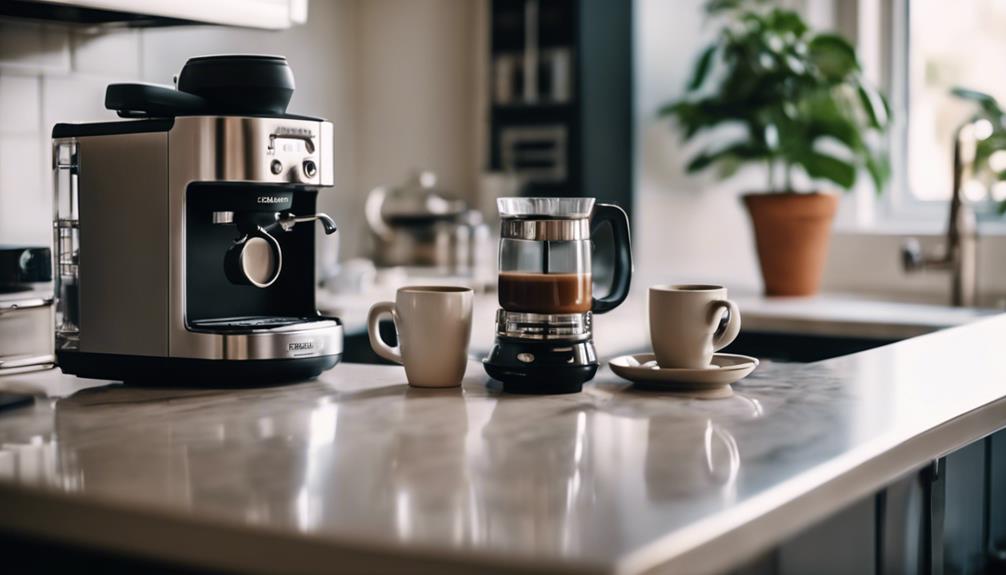
You're now the barista, bringing the coffee shop experience right into your own kitchen with the Breville Bambino's versatile capabilities.
With this machine, you can create a variety of coffee drinks that cater to your unique tastes. Whether you prefer a strong single shot or a rich double shot, the Breville Bambino has got you covered. You can use freshly ground coffee beans to make each shot, ensuring the best flavor possible.
The machine's quick setup and activation time of just three seconds mean you can enjoy your coffee without waiting around. Plus, with control over milk froth levels and temperature settings, you can customize your beverages to suit your taste.
Want a latte or cappuccino? No problem! The Breville Bambino makes it easy to create these popular coffee drinks at home. By using freshly frothed milk and expertly pulled shots, you'll be able to elevate your home coffee experience to new heights.
With the Breville Bambino, you'll be enjoying coffee shop-quality drinks in the comfort of your own home in no time.
Frequently Asked Questions
How to Make a Latte at Home With Breville Espresso Machine?
You're just a few steps away from a perfect latte! Start by brewing a double shot of espresso, then froth milk to your desired level using the steam wand, and combine for a beautiful layered effect.
Why Is Breville so Expensive?
You're likely wondering why Breville is pricey. It's due to the brand's focus on quality materials, innovative technology, and user-friendly features, which justify the higher cost for a premium coffee experience and long-term durability.
What Is the Best Grind Number for Breville Espresso?
You're seeking the perfect grind, balancing flavor and crema. Typically, a setting between 14 and 18 is ideal. You'll want to experiment, adjusting in small increments, to find your perfect shot, as you refine your espresso game.
Can You Put Ground Coffee in a Breville Espresso Machine Grinder?
You can't put ground coffee directly into the Breville Bambino's components, as it doesn't have a built-in grinder. Instead, you'll need to use a separate grinder to prepare the coffee before loading it into the machine.
Conclusion
You're now the maestro of your own coffee universe, with the Breville espresso maker as your trusted sidekick.
Just as a skilled artist weaves a masterpiece, you'll craft rich, velvety shots that awaken your senses.
As the aromatic espresso flows, imagine the morning sun bursting through your window, bathing your day in warmth and possibility.
Your coffee game has officially been elevated, and every sip is a reflection of your newfound mastery.
Espresso
What Is Espresso? Uncover the Secrets Behind This Bold Brew!
Behind the rich flavors and aromas of espresso lies a world of history, technique, and precision – discover its secrets.

You're about to discover the rich world of espresso, where a perfect blend of coffee beans, precise brewing techniques, and a dash of history come together to create a bold and complex brew. Espresso originated in 19th-century Italy, where innovators like Angelo Moriodo and Luigi Bezzera pioneered steam-driven coffee machines. To craft the perfect shot, you'll need high-quality beans, a balanced roast profile, and a fine grind size. With the right techniques and equipment, you can reveal the secrets of espresso and experience the vibrant flavors and aromas that make it a beloved morning ritual – and that's just the beginning.
Key Takeaways
- Espresso originated in 19th-century Italy, driven by increased coffee demand and the need for faster preparation.
- High-quality coffee beans, freshly roasted, yield rich flavor and aroma, with balanced roast profiles avoiding overly intense light roasts.
- The perfect brewing process involves optimal machine condition, fine grind size, consistent pressure, and peak extraction time of 25-30 seconds.
- Espresso brewing techniques require even tamping, ideal grind size, and proper extraction times for balanced flavor and improved extraction.
Origins of Espresso
When you explore the rich history of espresso, you'll find that it originated in 19th-century Italy as a response to the growing coffee demand and the need for faster coffee preparation in cafes. As coffee became an integral part of Italian culture, the need for a quicker brewing method became apparent.
Angelo Moriodo's invention of the first steam-driven coffee machine in 1884 marked the beginning of espresso's evolution. Luigi Bezzera improved upon Moriodo's design, using steam pressure to brew coffee, which laid the groundwork for modern espresso machines.
The term 'espresso' is derived from the Italian verb 'esprimere,' meaning 'to press out,' reflecting the method of extracting coffee rather than the speed of preparation. You might think that 'espresso' refers to the speed at which coffee is made, but it's actually about the process of forcing pressurized hot water through finely ground coffee.
Understanding the origins of espresso and its early innovators, like Moriodo and Bezzera, helps you appreciate the complexity of brewing coffee and the significance of Italy in shaping the world's coffee culture.
Delving into espresso's history can also help you refine your coffee palate and appreciation for the perfect cup.
The Perfect Brewing Process
To master the art of brewing espresso, you'll need to focus on several key elements that work together to create the perfect shot.
First, verify your espresso machine is in top condition, as it's the foundation of the brewing process.
Next, pay attention to the grind size of your coffee beans – a fine grind, similar to table salt, is ideal for even extraction and peak flavor.
When loading the portafilter, use 18-20 grams of coffee grounds for a single shot, which will result in a rich and concentrated brew.
Tamp the grounds with consistent pressure to promote balanced extraction and flavor.
Now, it's time to brew. The peak extraction time is between 25-30 seconds – too fast and the flavors will be weak, too slow and the shot will be bitter.
As you perfect the brewing process, you'll reveal the rich flavors that espresso has to offer.
With practice, you'll be able to coax out the unique characteristics of each coffee bean, creating a truly exceptional shot.
Ideal Coffee Bean Selection
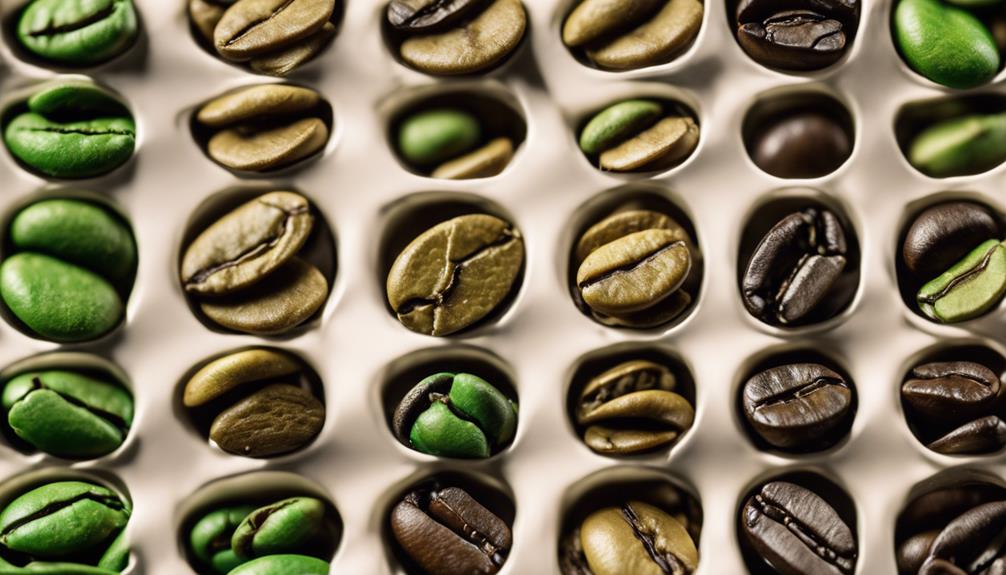
Selecting the right coffee beans is crucial for crafting exceptional espresso, and you'll want to focus on high-quality, freshly roasted beans that offer unique flavor profiles. When choosing beans, consider the roast profile and flavor profile you prefer. Here's a breakdown of key considerations:
| Bean Characteristics | Impact on Espresso |
|---|---|
| High-quality beans | Rich, vibrant flavor and aroma |
| Freshly roasted beans | Ideal flavor and aroma, with notes of fruit and chocolate |
| Balanced roast profile | Avoids overly intense light roasts, yielding a smooth, full-bodied espresso |
When selecting beans, you'll want to avoid those that are too light or too dark. Instead, opt for beans with a balanced roast profile that will yield a smooth, full-bodied espresso. High-quality beans are crucial for ideal flavor, and freshly roasted beans will guarantee the best possible taste. By choosing the right beans, you'll be well on your way to crafting exceptional espresso. Remember, the quality of the beans greatly influences espresso craftsmanship, so don't be afraid to experiment with different roast profiles and flavor profiles to find your perfect cup.
Espresso Roast Profile Explained
Now that you've selected the perfect coffee beans, it's time to explore the art of espresso roast profiles.
You'll want to understand the characteristics of espresso roasts, which are typically darker and roasted longer to bring out rich and bold flavors.
Espresso Roast Characteristics
When it comes to crafting the perfect espresso shot, understanding the nuances of espresso roast characteristics is key, as the roast profile plays a significant role in bringing out the desired flavors and aromas in your cup.
As you experiment with different espresso roast profiles, you'll discover that they often showcase a deeper, more caramelized flavor profile, thanks to the extended roasting time. However, keep in mind that achieving the perfect balance requires selecting the right type of coffee beans and fine-tuning your roast levels.
It's widely recognized that certain espresso beans – like lighter roasts – can yield overly intense flavors when brewed as espresso, resulting in a cup that's unbalanced and possibly bitter. Conversely, combining different coffee bean origins in the perfect proportion creates the magic blend you want.
That balance directly hinges on both beans you have to craft to effectively keep pace or resonate sound frequency. Yet, combining sound process procedures and putting the correct quantity can yield outstanding pure notes. This set blending produces the peak experience in your espresso.
Flavor Profile Balance
You're likely familiar with the concept that achieving a perfect balance in flavor profiles is vital for a great espresso experience, as it hinges on the delicate interplay between sweetness, acidity, and bitterness.
When it comes to espresso roast profiles, finding this balance is vital. Lighter roasts can be too intense if not roasted carefully, while darker roasts may become bitter if over-roasted. Adjusting roasting times and temperatures helps achieve the desired flavor balance, allowing for variations that cater to personal taste preferences.
To create a balanced espresso, roasters often blend different coffee grounds, including robusta beans, to enhance the caffeine content and introduce a fuller body. The ideal espresso roast profile should result in a harmonious combination of sweetness, acidity, and bitterness.
The presence of crema is a key indicator of the espresso's quality and flavor balance. By understanding how to balance flavor profiles, you'll be able to appreciate the nuances of different espresso roast profiles and find the perfect blend to suit your taste.
Whether you prefer a brighter, more acidic flavor or a richer, more robust taste, achieving flavor balance is vital for a great espresso experience.
Brewing Techniques and Tips
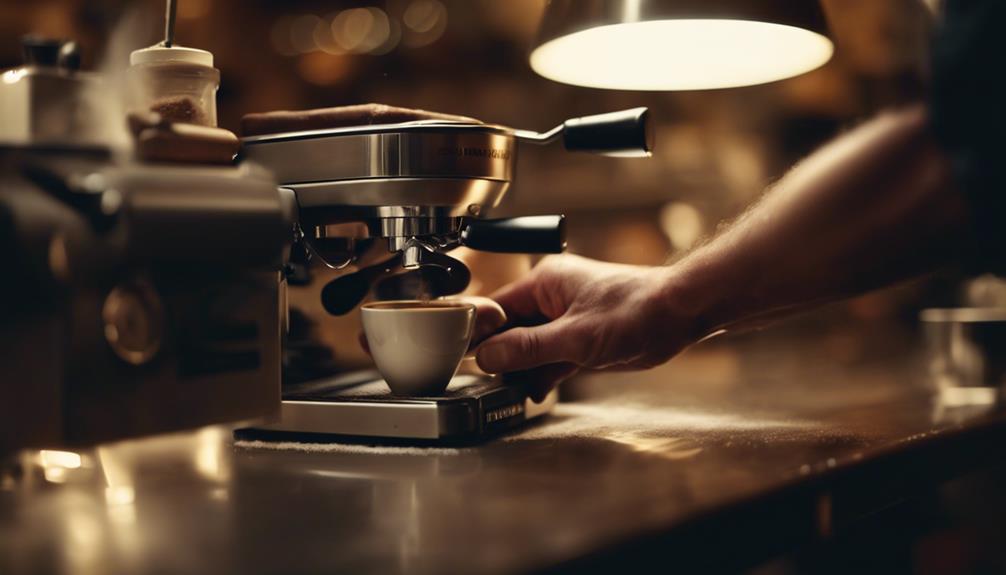
As you explore the world of espresso brewing, you'll quickly realize that perfecting the grind size is essential for achieving that perfect shot.
Mastering the grind size requires attention to detail and a bit of experimentation to find the ideal consistency.
Perfecting the Grind Size
To perfect the grind size for espresso, it's crucial to aim for a fine grind, similar to table salt, which is necessary for ideal extraction and rich flavor.
As you work to master the grind size, consider these key factors to optimize your brewing experience:
- Uniformity is key, and a burr grinder can help achieve the consistency needed for even extraction.
- A fine grind can enhance extraction but can also lead to bitterness if over-extracted.
- For a single shot of espresso, the ideal dose is between 18-20 grams of ground coffee, making precise measurements in grinding essential.
- Experimenting with different grind sizes affects the flavor profile; adjusting this is part of fine-tuning the espresso shot.
Keep these aspects in mind, and remember, fine-tuning your grind size with each use can guarantee your ground coffee complements your burr grinder for an unparalleled shot of espresso every time.
With consistent experimentation, you can enjoy that bold flavor everyone wants to know more about – every shot will deliver perfect and engaging outcomes in mastering that strong blend in brew form!
Mastering Brewing Techniques
Mastering brewing techniques is crucial for releasing the full flavor potential of your espresso, and it starts with understanding the importance of even tamping and precise water temperature control. When you tamp the coffee grounds evenly, you guarantee a balanced flavor profile and improved extraction quality. Additionally, monitoring the water temperature between 195-205°F during brewing is imperative, as this range greatly impacts the final taste of the espresso.
To achieve the perfect coffee, consider the following brewing techniques:
| Brewing Method | Water Temperature | Coffee-to-Water Ratio |
|---|---|---|
| Espresso | 195-205°F | 1:2 |
| Pour-over | 200-210°F | 1:15 |
| French press | 195-205°F | 1:12 |
When brewing espresso, use 18-20 grams of coffee grounds in the portafilter and aim for an extraction time of 25-30 seconds. This will prevent weak flavors from fast extractions or bitterness from slow extractions. By mastering these brewing techniques, you'll be able to bring out the unique flavors of your favorite beans and enjoy a perfect cup of coffee every time. With practice and patience, you'll become a skilled barista, capable of crafting exceptional espresso shots that impress even the most discerning coffee connoisseurs.
Fun Facts and Trivia
Discovering the lesser-known facts behind your favorite morning shot of espresso reveals a complex beverage that's full of surprising details, ranging from its etymology to brewing methods and misconceptions surrounding it.
As you sip on your espresso, you might be wondering what makes it so unique. Let's explore some fun facts and trivia that'll make you appreciate your daily cup even more.
Here are a few interesting tidbits about espresso:
- Espresso doesn't actually mean 'express' in Italian, but rather 'to press out' from the verb 'esprimere'.
- You might think espresso has more caffeine than filter coffee, but a standard serving of espresso actually contains less caffeine overall.
- Italian regulations require specific criteria for a shot of espresso to be considered true espresso, including minimum brewing pressure and extraction time.
- Historically, espresso blends often included robusta beans to increase caffeine content and enhance crema.
These facts show that there's more to espresso than just its bold flavors and rich aromas.
Whether you're a coffee connoisseur or just a casual fan, understanding the intricacies of espresso can enhance your appreciation for this beloved beverage.
Frequently Asked Questions
What Scientists Claim to Have Discovered the Secret to Perfect Espresso?
You're about to uncover the secret to perfect espresso! Scientists claim to have discovered that adding water before grinding coffee beans enhances consistency and taste, reducing static electricity and waste, and leading to stronger flavor extraction.
What Is Bold Espresso?
"Variety is the spice of life," and when it comes to bold espresso, you're in for a treat. You're brewing a concentrated coffee by forcing hot water through finely ground beans, resulting in a rich, strong flavor.
How Is Espresso Different From Coffee?
You're probably wondering how espresso differs from regular coffee. The main differences lie in brewing pressure, grind size, extraction time, and serving size, resulting in a richer, more intense flavor and a unique crema layer in espresso.
What Is the Difference Between Bold and Strong Coffee?
You might've noticed how some friends order "bold" coffee, while others ask for "strong" coffee. What's the difference? Think of it like music – bold coffee is like a rich, complex symphony, while strong coffee is more like a loud, intense beat.
Conclusion
As you wrap up your espresso journey, it's no coincidence that you've discovered the perfect blend of art and science.
The rich flavors and bold aromas have likely left you wondering how something so small can pack such a punch.
It's a coincidence that the same passion and dedication that goes into crafting each shot is the same passion that drives you to savor every last drop.
-

 Coffee Guides2 weeks ago
Coffee Guides2 weeks agoBoost Your Coffee: Easy Ways to Enhance Your Brew
-
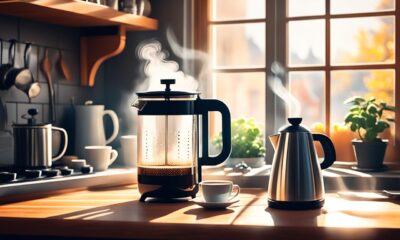
 Coffee Guides2 weeks ago
Coffee Guides2 weeks agoBrew Perfect Coffee at Home: Expert Tips & Tricks
-

 Health and Wellness2 weeks ago
Health and Wellness2 weeks agoHeadache-Free: How to Avoid Coffee Headaches!
-

 Vetted2 weeks ago
Vetted2 weeks ago15 Best Trundle Beds for Maximizing Space and Style in Your Home
-

 Coffee Guides2 weeks ago
Coffee Guides2 weeks agoBecome a Coffee Master: Expert Brewing Tips
-

 Coffee Guides2 weeks ago
Coffee Guides2 weeks agoBreve Coffee Explained: Your Cozy Café Favorite
-

 Coffee Guides2 weeks ago
Coffee Guides2 weeks agoHow to Be a Coffee Cup: Embrace Your Inner Brew
-

 Vetted2 weeks ago
Vetted2 weeks ago15 Best Rose Fertilizers to Keep Your Garden Blooming All Season Long
















